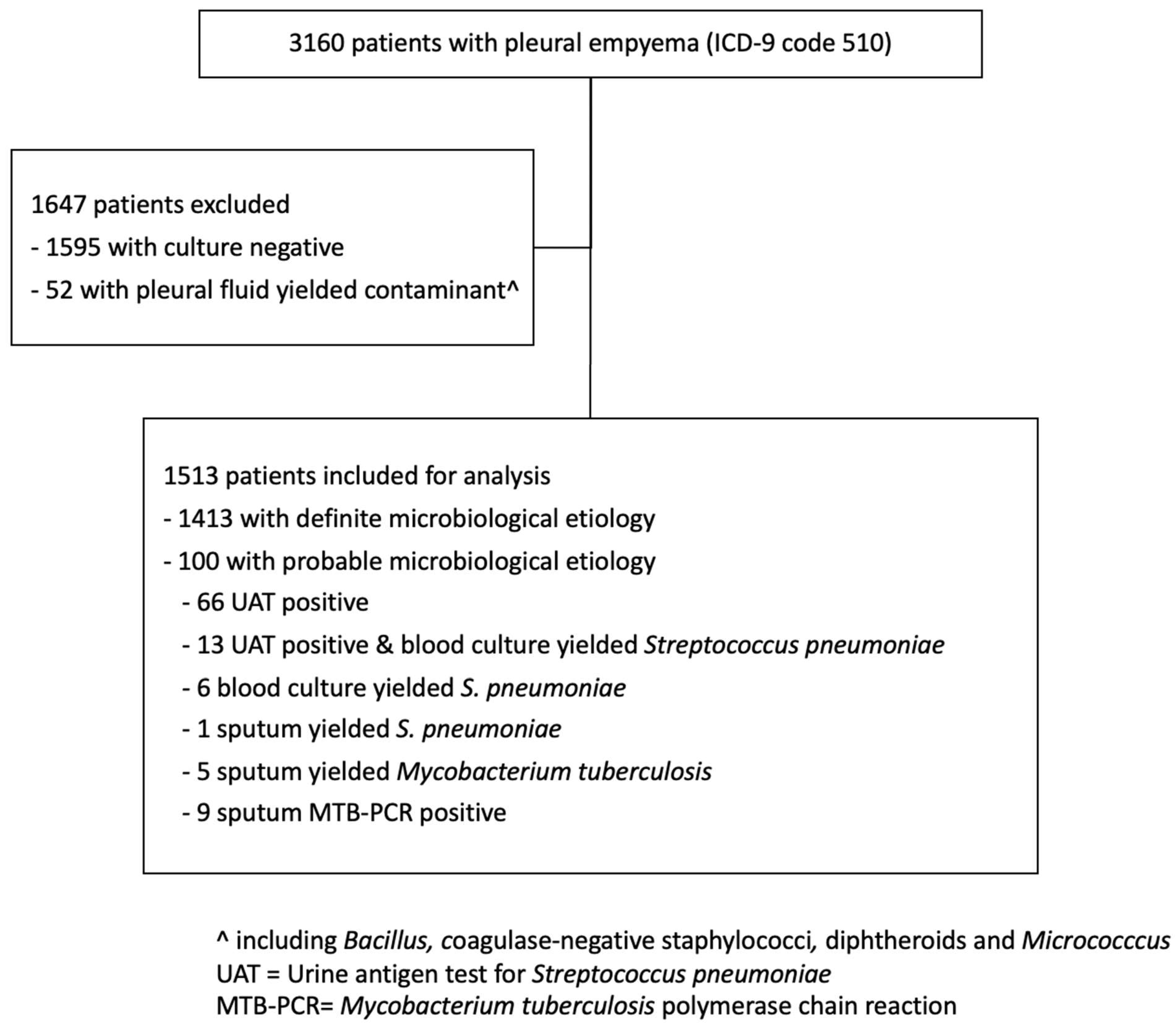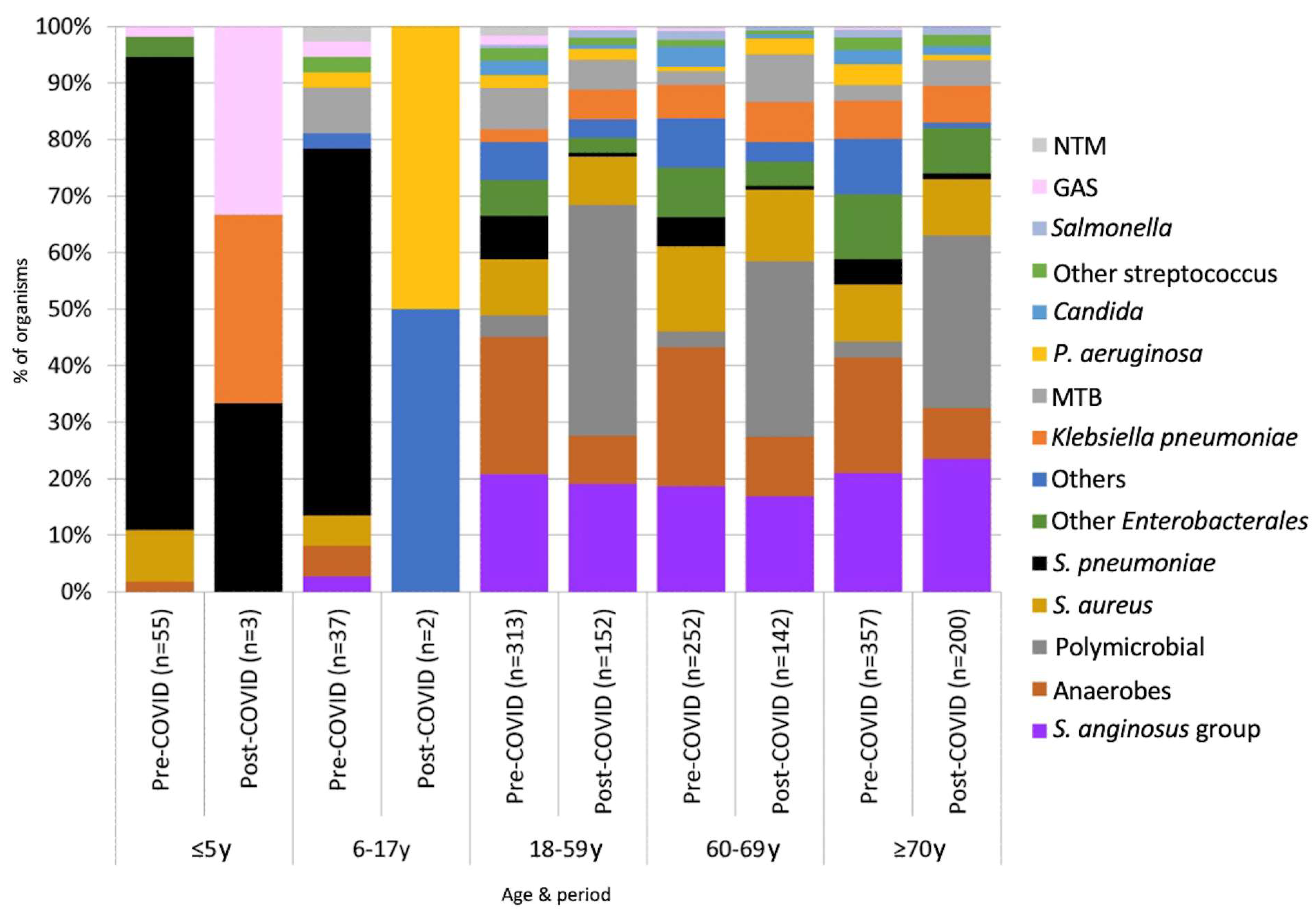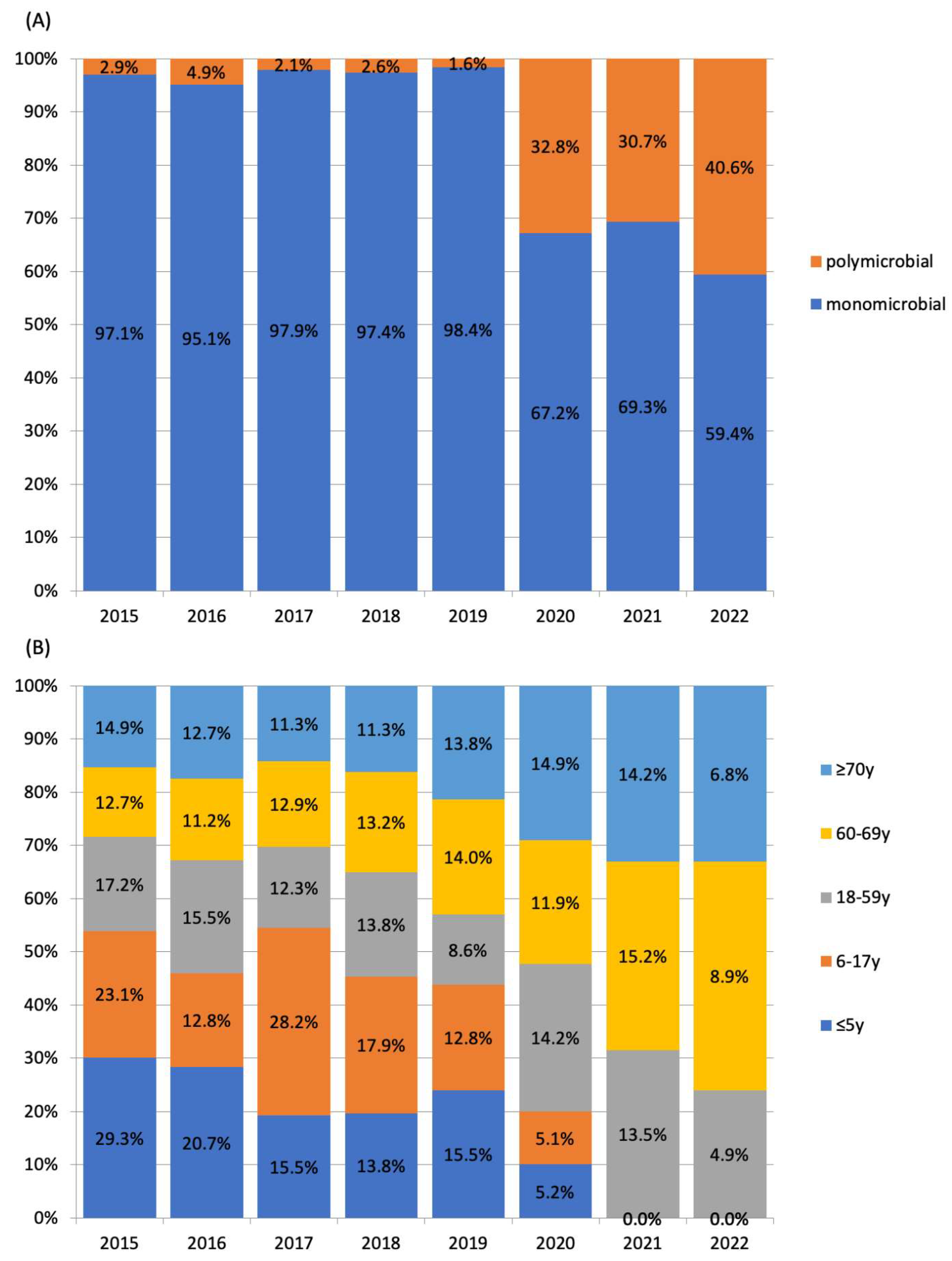Changes in Etiology and Clinical Outcomes of Pleural empyema during the COVID-19 Pandemic
Abstract
1. Introduction
2. Materials and Methods
2.1. Study Design
2.2. Data Source
2.3. Inclusion/ Exclusion Criteria
2.4. Outcome
2.5. Statistical Analysis
3. Results
3.1. Patients Demographics
3.2. Pleural Empyema Etiology
3.3. Incidence of Pleural Empyema and Etiology by Time Periods and Age Groups
3.4. Pleural Empyema in COVID-19 Patients
3.5. Clinical Outcomes of Pleural Empyema in the Pre- and Post-COVID-19 Periods
4. Discussion
5. Conclusions
Author Contributions
Funding
Institutional Review Board Statement
Informed Consent Statement
Data Availability Statement
Acknowledgments
Conflicts of Interest
References
- Davies, H.E.; Davies, R.J.; Davies, C.W.; BTS Pleural Disease Guideline Group. Management of pleural infection in adults: British Thoracic Society Pleural Disease Guideline 2010. Thorax 2010, 65 (Suppl. 2), ii41–ii53. [Google Scholar] [CrossRef] [PubMed]
- Maskell, N.A.; Davies, C.W.; Nunn, A.; Hedley, E.L.; Gleeson, F.V.; Miller, R.; First Multicenter Intrapleural Sepsis Trial (MIST1) Group. U.K. Controlled trial of intrapleural streptokinase for pleural infection. N. Engl. J. Med. 2005, 352, 865–874. [Google Scholar] [CrossRef] [PubMed]
- Maskell, N.A.; Batt, S.; Hedley, E.L.; Davies, C.W.; Gillespie, S.H.; Davies, R.J. The bacteriology of pleural infection by genetic and standard methods and its mortality significance. Am. J. Respir. Crit. Care Med. 2006, 174, 817–823. [Google Scholar] [CrossRef] [PubMed]
- Malhotra, P.; Aggarwal, A.N.; Agarwal, R.; Ray, P.; Gupta, D.; Jindal, S.K. Clinical characteristics and outcomes of empyema thoracis in 117 patients: A comparative analysis of tuberculous vs. non-tuberculous aetiologies. Respir. Med. 2007, 101, 423–430. [Google Scholar] [CrossRef]
- Rahman, N.M.; Maskell, N.A.; West, A.; Teoh, R.; Arnold, A.; Mackinlay, C.; Peckham, D.; Davies, C.W.; Ali, N.; Kinnear, W.; et al. Intrapleural use of tissue plasminogen activator and DNase in pleural infection. N. Engl. J. Med. 2011, 365, 518–526. [Google Scholar] [CrossRef] [PubMed]
- Cucinotta, D.; Vanelli, M. WHO declares COVID-19 a pandemic. Acta Biomed. 2020, 91, 157–160. [Google Scholar] [PubMed]
- Chan, K.P.F.; Ma, T.F.; Kwok, W.C.; Leung, J.K.C.; Chiang, K.Y.; Ho, J.C.M.; Lam, D.C.L.; Tam, T.C.C.; Ip, M.S.M.; Ho, P.L. Significant reduction in hospital admissions for acute exacerbation of chronic obstructive pulmonary disease in Hong Kong during coronavirus disease 2019 pandemic. Respir. Med. 2020, 171, 106085. [Google Scholar] [CrossRef]
- Chan, K.P.F.; Kwok, W.C.; Ma, T.F.; Hui, C.H.; Tam, T.C.C.; Wang, J.K.L.; Ho, J.C.M.; Lam, D.C.L.; Sau-Man Ip, M.; Ho, P.L. Territory-wide study on hospital admissions for asthma exacerbations in the COVID-19 pandemic. Ann. Am. Thorac. Soc. 2021, 18, 1624–1633. [Google Scholar] [CrossRef]
- Chan, K.F.; Ma, T.F.; Ip, M.S.; Ho, P.L. Invasive pneumococcal disease, pneumococcal pneumonia and all-cause pneumonia in Hong Kong during the COVID-19 pandemic compared with the preceding 5 years: A retrospective observational study. BMJ Open 2021, 11, e055575. [Google Scholar] [CrossRef]
- Brueggemann, A.B.; van Rensburg, M.J.J.; Shaw, D.; McCarthy, N.D.; Jolley, K.A.; Maiden, M.C.; van der Linden, M.P.; Amin-Chowdhury, Z.; Bennett, D.E.; Borrow, R.; et al. Changes in the incidence of invasive disease due to Streptococcus pneumoniae, Haemophilus influenzae, and Neisseria meningitidis during the COVID-19 pandemic in 26 countries and territories in the Invasive Respiratory Infection Surveillance Initiative: A prospective analysis of surveillance data. Lancet Digit Health 2021, 3, e360–e370. [Google Scholar]
- Vollmer, M.A.; Radhakrishnan, S.; Kont, M.D.; Flaxman, S.; Bhatt, S.; Costelloe, C.; Honeyford, K.; Aylin, P.; Cooke, G.; Redhead, J.; et al. The impact of the COVID-19 pandemic on patterns of attendance at emergency departments in two large London hospitals: An observational study. BMC Health Serv. Res. 2021, 21, 1008. [Google Scholar] [CrossRef] [PubMed]
- Lau, V.I.; Dhanoa, S.; Cheema, H.; Lewis, K.; Geeraert, P.; Lu, D.; Merrick, B.; Vander Leek, A.; Sebastianski, M.; Kula, B.; et al. Non-COVID outcomes associated with the coronavirus disease-2019 (COVID-19) pandemic effects study (COPES): A systematic review and meta-analysis. PLoS ONE 2022, 17, e0269871. [Google Scholar] [CrossRef] [PubMed]
- Lazzerini, M.; Barbi, E.; Apicella, A.; Marchetti, F.; Cardinale, F.; Trobia, G. Delayed access or provision of care in Italy resulting from fear of COVID-19. Lancet Child Adolesc. Health 2020, 4, e10–e11. [Google Scholar] [CrossRef] [PubMed]
- Alshahrani, M.S.; Alfaraj, D.; AlHumaid, J.; Alshahrani, K.; Alsubaie, A.; Almulhim, N.; Althawadi, D.; Alam, S.; Alzahrani, M.; Alwosibai, H.; et al. Prevalence, causes, and adverse clinical impact of delayed presentation of non-COVID-19-related emergencies during the COVID-19 pandemic: Findings from a multicenter observational study. Int. J. Environ. Res. Public Health 2022, 19, 9818. [Google Scholar] [CrossRef] [PubMed]
- Schirmer, C.M.; Ringer, A.J.; Arthur, A.S.; Binning, M.J.; Fox, W.C.; James, R.F.; Levitt, M.R.; Tawk, R.G.; Veznedaroglu, E.; Walker, M.; et al. Delayed presentation of acute ischemic strokes during the COVID-19 crisis. J. Neurointerv. Surg. 2020, 12, 639–642. [Google Scholar] [CrossRef] [PubMed]
- Tam, C.C.F.; Cheung, K.S.; Lam, S.; Wong, A.; Yung, A.; Sze, M.; Lam, Y.M.; Chan, C.; Tsang, T.C.; Tsui, M.; et al. Impact of Coronavirus Disease 2019 (COVID-19) outbreak on ST-segment-elevation myocardial infarction care in Hong Kong, China. Circ. Cardiovasc. Qual. Outcomes 2020, 13, e006631. [Google Scholar] [CrossRef]
- Hospital Authority Statistical Report. Available online: https://www3.ha.org.hk/data/HAStatistics/DownloadReport/2 (accessed on 1 December 2022).
- Corder, G.W.; Foreman, D.I. Nonparametric Statistics: A Step-by-Step Approach, 2nd ed.; Wiley: Hoboken, NJ, USA, 2014. [Google Scholar]
- Weisberg, S. Applied Linear Regression, 4th ed.; Wiley: Hoboken, NJ, USA, 2013. [Google Scholar]
- Agresti, A. An Introduction to Categorical Data Analysis, 2nd ed.; Wiley-Interscience: Hoboken, NJ, USA, 2007. [Google Scholar]
- Ho, P.L.; Law, P.Y.; Chiu, S.S. Increase in incidence of invasive pneumococcal disease caused by serotype 3 in children eight years after the introduction of the pneumococcal conjugate vaccine in Hong Kong. Hum. Vaccin. Immunother. 2019, 15, 455–458. [Google Scholar] [CrossRef]
- Alsaegh, A.; Belova, E.; Vasil’ev, Y.; Zabroda, N.; Severova, L.; Timofeeva, M.; Dobrokhotov, D.; Leonova, A.; Mitrokhin, O. COVID-19 in dental settings: Novel risk assessment approach. Int. J. Environ. Res. Public Health 2021, 18, 6093. [Google Scholar] [CrossRef]
- Dickson-Swift, V.; Kangutkar, T.; Knevel, R.; Down, S. The impact of COVID-19 on individual oral health: A scoping review. BMC Oral Health 2022, 22, 422. [Google Scholar] [CrossRef] [PubMed]
- Lin, Y.C.; Chen, H.J.; Liu, Y.H.; Shih, C.M.; Hsu, W.H.; Tu, C.Y. A 30-month experience of thoracic empyema in a tertiary hospital: Emphasis on differing bacteriology and outcome between the medical intensive care unit (MICU) and medical ward. South Med. J. 2008, 101, 484–489. [Google Scholar] [CrossRef]
- Yamazaki, A.; Ito, A.; Ishida, T.; Washio, Y. Polymicrobial etiology as a prognostic factor for empyema in addition to the renal, age, purulence, infection source, and dietary factors score. Respir. Investig. 2019, 57, 574–581. [Google Scholar] [CrossRef] [PubMed]
- Kanellakis, N.I.; Wrightson, J.M.; Gerry, S.; Ilott, N.; Corcoran, J.P.; Bedawi, E.O.; Asciak, R.; Nezhentsev, A.; Sundaralingam, A.; Hallifax, R.J.; et al. The bacteriology of pleural infection (TORPIDS): An exploratory metagenomics analysis through next generation sequencing. Lancet Microbe 2022, 3, e294–e302. [Google Scholar] [CrossRef] [PubMed]
- Bobbio, A.; Bouam, S.; Frenkiel, J.; Zarca, K.; Fournel, L.; Canny, E.; Icard, P.; Porcher, R.; Alifano, M. Epidemiology and prognostic factors of pleural empyema. Thorax 2021, 76, 1117–1123. [Google Scholar] [CrossRef] [PubMed]
- Divisi, D.; Zaccagna, G.; Angeletti, C.; Cicerone, E.; De Vico, A.; Moretti, R.; Imbriglio, G.; Carbuglia, N.; Quaglione, G.R.; Chiatamone Ranieri, S.; et al. Pleural empyema associated with alveolar-pleural fistulas in severe acute respiratory syndrome coronavirus 2. Clin. Case Rep. 2021, 9, e04262. [Google Scholar] [CrossRef] [PubMed]
- McCraw, C.; Forbush, S.; Trivedi, K. Community-acquired, post-COVID-19, methicillin-resistant Staphylococcus aureus pneumonia and empyema. Cureus 2022, 14, e22121. [Google Scholar] [CrossRef] [PubMed]
- Ayad, S.; Gergis, K.; Elkattawy, S.; Mirza, N.; Abdelazeem, B.; Patel, L.; Remolina, C. Loculated Empyema and SARS-CoV-2 Infection: A report of two cases and review of the literature. Eur. J. Case Rep. Intern. Med. 2021, 8, 002706. [Google Scholar] [CrossRef]
- Qin, C.; Zhou, L.; Hu, Z.; Zhang, S.; Yang, S.; Tao, Y.; Xie, C.; Ma, K.; Shang, K.; Wang, W.; et al. Dysregulation of immune response in patients With Coronavirus 2019 (COVID-19) in Wuhan, China. Clin. Infect. Dis. 2020, 71, 762–768. [Google Scholar] [CrossRef]
- Ruan, S.Y.; Chuang, Y.C.; Wang, J.Y.; Lin, J.W.; Chien, J.Y.; Huang, C.T.; Kuo, Y.W.; Lee, L.N.; Chong-Jen, J.Y. Revisiting tuberculous pleurisy: Pleural fluid characteristics and diagnostic yield of mycobacterial culture in an endemic area. Thorax 2012, 67, 822–827. [Google Scholar] [CrossRef]



| Organism Groups | No. (%) of Pleural Empyema Containing the Organism | ||
|---|---|---|---|
| Monomicrobial | Polymicrobial a, b | Total b | |
| Anaerobes | 260 | 111 | 371 (24.5) |
| Streptococcus anginosus group | 288 | 52 | 340 (22.5) |
| Staphylococcus aureus | 163 | 25 | 188 (12.4) |
| Streptococcus pneumoniae | 128 | 12 | 140 (9.3) |
| Other Enterobacterales | 111 | 9 | 120 (7.9) |
| Klebsiella pneumoniae | 78 | 11 | 89 (5.9) |
| MTB | 71 | 3 | 74 (4.9) |
| Candida | 31 | 15 | 46 (3.0) |
| Pseudomonas aeruginosa | 33 | 9 | 42 (2.8) |
| Other streptococcus | 26 | 4 | 30 (2.0) |
| Salmonella | 17 | 1 | 18 (1.2) |
| Group A streptococcus | 11 | 0 | 11 (0.7) |
| NTM | 8 | 1 | 9 (0.6) |
| Others | 92 | 92 (6.1) | |
| Total | 1317 | 196 | 1513 (100) |
| No. of Patients | |||||
|---|---|---|---|---|---|
| ≤5 y | 18–59 y | 60–69 y | ≥70 y | Total | |
| Etiology | |||||
| Polymicrobial a | 1 | 4 | 1 | 6 | |
| Streptococcus anginosis | 2 | 3 | 5 | ||
| Staphylococcus aureus | 2 | 1 | 3 | ||
| Pseudomonas aeruginosa | 1 | 1 | 2 | ||
| Salmonella group D | 1 | 1 | |||
| Streptococcus pneumoniae | 1 | 1 | |||
| Enterococcus faecium | 1 | 1 | |||
| Escherichia coli | 1 | 1 | |||
| Haemophilus influenzae | 1 | 1 | |||
| Subtotal | 1 | 3 | 9 | 8 | 21 |
| Outcome | |||||
| ICU admission | 0 | 0 | 4 | 1 | 5 |
| Need tPA/DNase | 0 | 0 | 0 | 1 | 1 |
| Surgical intervention | 0 | 0 | 1 | 0 | 1 |
| Death | 0 | 1 | 2 | 2 | 5 |
| Outcomes | Pre-COVID-19 Period (n = 1014) | Post-COVID-19 Period (n = 499) | % (95% CI) Difference |
|---|---|---|---|
| LOS, median ± IQR | 24 ± 25 days | 23 ± 21 days | |
| ICU admission | 11.3% | 13.6% | +2.3% (−1.1% to 6.0%) |
| IPFT | 2.5% | 8.4% | +5.9% (3.5% to 8.8%) |
| Surgical intervention | 10.5% | 7.8% | −2.7% (−5.6% to 0.5%) |
| Episode death | 18.4% | 20.6% | +2.2% (−1.9% to 6.6%) |
| Coefficient | Odds Ratio (95% Confidence Interval), Logistic Regression | ||||
|---|---|---|---|---|---|
| Longer LOS | ICU Admission | IPFT | Surgical Management | Death | |
| Age | 1.36 (0.14 to 2.58) | 1.00 (0.99–1.02) | 1.01 (0.99–1.02) | 1.00 (0.99–1.01) | 1.03 (1.02–1.05) * |
| Male sex | 5.71 (1.20 to 10.21) | 0.97 (0.67–1.40) | 1.51 (0.86–2.62) | 1.42 (0.92–2.19) | 1.21 (0.87–1.68) |
| CCI score | −0.48 (−1.36 to 0.40) | 0.92 (0.85–1.00) | 0.95 (0.84–1.07) | 0.78 (0.70–0.87) * | 1.16 (1.10–1.23) * |
| Etiology | |||||
| Polymicrobial | 10.04 (3.96 to 16.11) * | 1.66 (1.06–2.59) | 0.57 (0.25–1.30) | 1.54 (0.90–2.63) | 1.66 (1.10–2.52) |
| Anaerobes a | −13.08 (−18.22 to −7.94) * | 1.13 (0.76–1.68) | 0.32 (0.16–0.66) * | 0.56 (0.34–0.91) | 0.58 (0.40–0.85) * |
| S. anginosusa | −15.07 (−20.17 to −9.96) * | 1.16 (0.78–1.72) | 0.26 (0.13–0.51) * | 0.47 (0.28–0.79) * | 0.43 (0.29–0.64) * |
| S. aureusa | −2.40 (−8.76 to 3.96) | 2.32 (1.20–4.49) | 0.45 (0.18–1.12) | 1.74 (1.04–2.90) | 1.00 (0.66–1.51) |
| S. pneumoniaea | −7.47 (−16.02 to 1.08) | 1.52 (0.70–3.28) | 0.64 (0.17–2.28) | 0.24 (0.06–1.02) | 1.50 (0.90–2.48) |
| Season (c/f autumn) | |||||
| Winter | −2.17 (−8.11 to 3.76) | 1.05 (0.66–1.67) | 0.85 (0.39–1.95) | 0.92 (0.56–1.54) | 1.05 (0.70–1.55) |
| Spring | −3.04 (−8.98 to 2.91) | 1.10 (0.71–1.71) | 1.03 (0.50–2.10) | 1.00 (0.61–1.66) | 0.94 (0.64–1.37) |
| Summer | 1.28 *(−4.07 to 6.64) | 1.24 (0.78–1.95) | 1.45 (0.72–2.93) | 1.16 (0.70–1.93) | 0.71 (0.47–1.07) |
Disclaimer/Publisher’s Note: The statements, opinions and data contained in all publications are solely those of the individual author(s) and contributor(s) and not of MDPI and/or the editor(s). MDPI and/or the editor(s) disclaim responsibility for any injury to people or property resulting from any ideas, methods, instructions or products referred to in the content. |
© 2023 by the authors. Licensee MDPI, Basel, Switzerland. This article is an open access article distributed under the terms and conditions of the Creative Commons Attribution (CC BY) license (https://creativecommons.org/licenses/by/4.0/).
Share and Cite
Chan, K.-P.F.; Ma, T.-F.; Sridhar, S.; Lam, D.C.-L.; Ip, M.S.-M.; Ho, P.-L. Changes in Etiology and Clinical Outcomes of Pleural empyema during the COVID-19 Pandemic. Microorganisms 2023, 11, 303. https://doi.org/10.3390/microorganisms11020303
Chan K-PF, Ma T-F, Sridhar S, Lam DC-L, Ip MS-M, Ho P-L. Changes in Etiology and Clinical Outcomes of Pleural empyema during the COVID-19 Pandemic. Microorganisms. 2023; 11(2):303. https://doi.org/10.3390/microorganisms11020303
Chicago/Turabian StyleChan, King-Pui Florence, Ting-Fung Ma, Siddharth Sridhar, David Chi-Leung Lam, Mary Sau-Man Ip, and Pak-Leung Ho. 2023. "Changes in Etiology and Clinical Outcomes of Pleural empyema during the COVID-19 Pandemic" Microorganisms 11, no. 2: 303. https://doi.org/10.3390/microorganisms11020303
APA StyleChan, K.-P. F., Ma, T.-F., Sridhar, S., Lam, D. C.-L., Ip, M. S.-M., & Ho, P.-L. (2023). Changes in Etiology and Clinical Outcomes of Pleural empyema during the COVID-19 Pandemic. Microorganisms, 11(2), 303. https://doi.org/10.3390/microorganisms11020303







